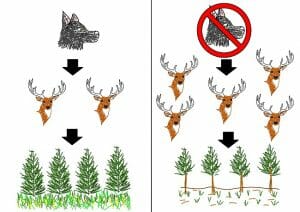Extirpation Definition
Extirpation (also known as ‘local extinction’) describes the situation in which a species or population no longer exists within a certain geographical location. Unlike extinction, whereby a species no longer exists anywhere, extirpation means that at least one other population of the species still persists in other areas.
Most species of plants and animals have a number of different breeding populations, which exist either globally or within a defined region or habitat. This means that when a population ceases to exist in a certain area, the other populations remain to keep the species extant (still in existence).
Since the entire species is not extinct, it is possible for populations to recolonize after extirpation. However, this can sometimes lead to a reduction in genetic diversity.
The habitat ranges of populations may also naturally shift in response to changes in abiotic factors (e.g., climatic changes) or changes in biotic factors (e.g., the availability of food, or the presence of predators and competitive species). Therefore, when a population migrates and no longer exists within a certain range, it has been extirpated from that area.
Human activities are largely responsible for local extinctions, either directly through hunting or trapping, or indirectly through processes such as habitat disturbance and destruction, introducing invasive species, removing or damaging resources, and polluting.
The extirpation of organisms from a habitat can have significant ecological effects. For example, the removal of predators from a habitat can result in increased population sizes of species in lower trophic levels, which can further increase pressure on other resources such as vegetation; this effect is called a trophic cascade.
Examples of Extirpation
Extirpation of Gray Wolves
A common example of extirpation is the human-caused local extinction of the gray wolf (Canis lupus) from around two-thirds of their historic natural habitat range.
Gray wolves used to be distributed widely across the Northern Hemisphere, throughout North America, Canada, Europe and Asia. However, due to conflict with humans over livestock predation and fear of attacks, populations were extirpated from many of their habitats.
In the early 1900s, the American government declared wolves as vermin, and humans targeted the wolves directly as an organized extermination effort. This reduced the American populations of gray wolves dramatically and resulted in their extirpation from all but two states—a population of around 300 individuals remained in Minnesota and Michigan.
In areas such as the Yellowstone National Park, where the wolves had been completely eradicated—the last remaining wolves were shot in 1926—populations of elk and other natural prey became uncontrollably large. The herbivore populations grazed intensely on vegetation, which affected the available resources and thus the presence of other animals such as beavers and bears. The removal of wolves had caused a trophic cascade!

The image shows the effect of a trophic cascade, which can be caused when a population becomes locally extinct.
In 1995, wolves were reintroduced into Yellowstone Park and then began to predate and change the behavior of the elk, reducing the effect on the vegetation. Other species have begun to return, and the wolf population is growing, returning the important ecosystem to a more natural state.
Despite the success of the Yellowstone Park reintroduction, the gray wolf is still missing from the majority of its natural global habitat range. Local populations are still significantly reduced, and the species is mostly absent from Western Europe. It is unlikely that the populations can return to their natural levels due to the presence of humans and a lack of appropriate habitat.
Extirpation through Species Introductions
The introduction of invasive species into an environment can have severe consequences for the local biodiversity. Animals or plants, which are introduced either accidentally or on purpose, and that predate or compete with native species for resources such as food, can cause local extinctions.
An example of this is the introduction of the brown tree snake (Boiga irregularis) to the Hawaiian island of Guam. This species was accidentally transported to Guam by boat around the 1950s and was hugely successful in colonizing, due to a lack of predators and an abundance of vulnerable prey on the island.
Within a few decades, the presence of the snake led to the extirpation of 12 of the 22 native bird species, and the complete extinction of several other endemic bird and mammal species. Not only has the snake’s presence led to extirpation on the island, many bird species are extirpated from the forested areas due to the threat of predation. This is having an effect on the reproduction of forest trees, as the bird pollinators are no longer present.
Related Biology Terms
- Global Extinction – The complete and irreversible removal or end of a species, usually signified by the death of the last remaining individual.
- Ecological Extinction – A reduction in the number of individuals within a population, to such low levels that they no longer interact with their environment or with other species.
- Extant – A species or population that is still in existence, the opposite of extinct.
- Population – The community of organisms within an area, in which interbreeding occurs.
Quiz
1. Extirpation means:
A. The loss of an entire species
B. Reduction in range size of a population within an area
C. The loss of a population from a certain area
D. A reduction in the number of individuals in an area
2. What is the main cause of global species extirpation?
A. Changes in weather
B. Human activities
C. Migration
D. Competition
